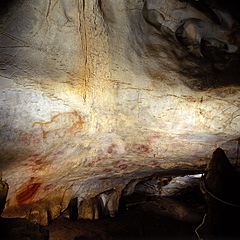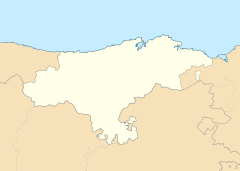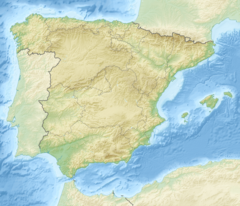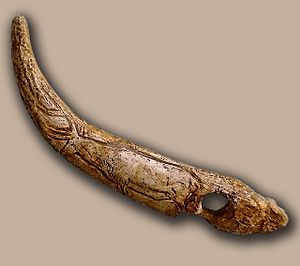Cave of El Castillo facts for kids
|
Cueva del Castillo
|
|

Main room
|
|
| Alternative name | Cave of the Castle |
|---|---|
| Location | Puente Viesgo (Cantabria), Spain |
| Coordinates | 43°17′32″N 3°57′55″W / 43.29222°N 3.96528°W |
| Type | Cave |
| Part of | Caves of Monte Castillo |
| Official name: Monte Castillo - El Castillo | |
| Type: | Cultural |
| Criteria: | i, iii |
| Designated: | 1985 (9th session) |
| Part of: | Cave of Altamira and Paleolithic Cave Art of Northern Spain |
| Reference #: | 310-009 |
| Region: | Europe and North America |
| Official name: Cueva del Castillo | |
| Type: | Non-movable |
| Criteria: | Monument |
| Designated: | 25 April 1924 |
| Reference #: | RI-51-0000267 |
The Cueva del Castillo, also known as the Cave of the Castle, is an amazing archaeological site in Spain. It is part of a group of caves called the Caves of Monte Castillo. You can find it in Puente Viesgo, a town in the region of Cantabria.
This cave is super important because it shows us how people lived long, long ago. Scientists have found many layers of history inside. These layers, called stratigraphy, are like pages in an old book. They show us different time periods, from the very early Stone Age (called the Proto-Aurignacian) all the way to the Bronze Age.
One of the most exciting discoveries here is some of the oldest cave painting ever found! It's a big red circle made of dots. This painting is in a part of the cave called the Panel de las Manos (Panel of Hands). Scientists used a special method called uranium-thorium dating to figure out its age. They found it is more than 40,000 years old! This means it was painted when the first modern humans arrived in Europe.
Discovering the Ancient Art
The Cueva del Castillo was first found in 1903. A Spanish archaeologist named Hermilio Alcalde del Río discovered it. He was one of the first people to study ancient cave paintings in the Cantabria region.
When the cave was first found, its entrance was smaller. It has been made bigger over time by archaeologists doing their work. Alcalde del Río found many incredible drawings and marks on the cave walls and ceilings. These were made using charcoal and red ochre, which is a natural earth pigment.
What Kind of Art is Inside?
The art in the cave covers a huge amount of time. It ranges from the Lower Paleolithic (a very early part of the Stone Age) to the Bronze Age. Some markings are even from the Middle Ages!
There are more than 150 different pictures and symbols that have been recorded. Many of these show animals, like deer. Some of the deer drawings are very detailed and even have shading.
Who Made the Handprints?
One interesting type of art found in the cave are hand stencils. These are made by placing a hand on the wall and blowing paint around it. For a long time, people thought that mostly men made these kinds of cave art.
However, a study in 2013 looked at the finger lengths in hand stencils found in caves in France and Spain. This study found that most of the handprints were actually from women! This changed what we thought about who created this ancient art.
See also
 In Spanish: Cueva de El Castillo para niños
In Spanish: Cueva de El Castillo para niños
- Art of the Upper Paleolithic
- List of Stone Age art
- Cave of La Pasiega




